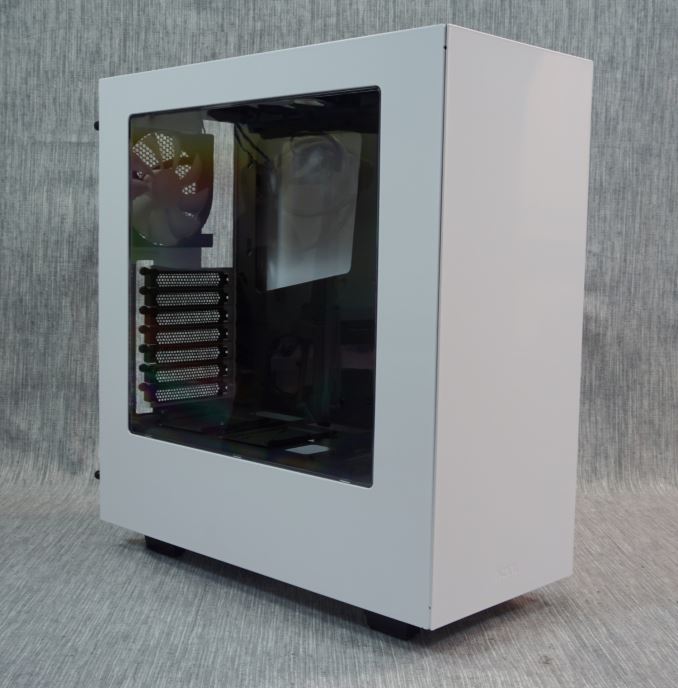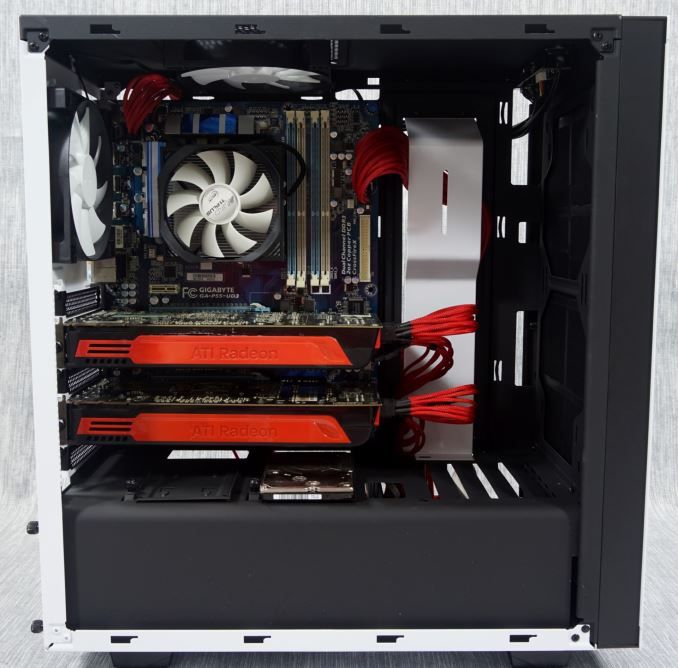The NZXT S340 Case Review
by E. Fylladitakis on July 13, 2015 8:00 AM EST- Posted in
- Cases/Cooling/PSUs
- NZXT
- Case
- ODD-Free
Conclusion
We should start our conclusion stating the simple fact that the NZXT S340 lacks 5.25" device mounts and there are no options for any form of optical media devices, therefore those that do want to install an ODD should instantly look elsewhere or invest in a USB ODD drive. NZXT designed the S340 to be a competitively priced, compact and visually elegant solution for a home and a gaming PC. The retail price of just $81 including shipping definitely is appealing, yet there are several shortcomings that need to be considered first.
Aesthetics are a subjective topic. It is natural that some will love the appearance of the S340, while others will not. In our opinion, the design of the S340 is very simple and straightforward. Those driven by minimalism will love the plain design of the S340 and the contrast between the glossy white and matte black colors. On the other hand, the S340 is far too plain and the flat surfaces are cold and uninspiring, so it may look out of place in a modern environment or in a youth's room.
Although aesthetics are a subjective topic, quality is not. Mechanically, the NZXT S340 is a rather solid design, without significant apparent issues. Still, the quality of the paint job is concerning. In particular, the matte black paint is very susceptible to scratches and requires a lot of attention when working inside the case or when placing items on top of it. We did not face any issues with the white glossy paint during our short time with the S340, which is significantly better applied, yet we were worried that it could lose its luster and become damp, especially if cleaning chemicals were applied. We tested that theory by applying common household cleaning compounds and the glossy paint of the S340 remained unscathed. On the other hand, bleach and dipentene dampened the surface of the S340 almost instantly and irreversibly. It would be very wise to use only very soft chemicals or no chemicals at all while cleaning the S340.
Aside from the obvious inability to use a 5.25" device or even an external 3.5" device, the S340 is a relatively practical product but there still are some shortcomings. The user is limited to two 2.5" drives and three 3.5" drives. No 2.5" drives can be installed in the 3.5" bays and there are no other expansion options. Still, the number of drives should be more than enough for the majority of home and gaming PCs. It also lacks any "luxurious" features, such as rubber grommets to cover the cable holes, fan controllers or even a cover for the large opening and exposed screws of the expansion cards. On the other hand, the spacious rear of the motherboard tray and the concept of the cable management bar greatly aid the user to assemble a very clean system. The only issue here is that the cable ties on the management bar warrant that they will have to be cut each time that the bar needs to come off or when there are significant system changes.
From a purely practical point of view, the NZXT S340 is the perfect case for those that want to assemble a good home/gaming PC and keep it untouched for a relatively long time. It is spacious enough to hold powerful components, large coolers and liquid cooling options. On the other hand, the lack of ODD support and the relatively small number of drive slots are insignificant flaws for the majority of home PC users, and especially gamers. If the plain appearance and practical simplicity of the NZXT S340 are considered and found acceptable, its low retail price and compact design make it a very competitive product that should easily find its way among the top slots of a shopping shortlist.
Additional: Due to great timing, for those keeping track of our Build-A-Rig project, the NZXT S340 (black) was chosen by Zotac for their $1500 gaming build as part of the minimalist design and aesthetic. With Build-A-Rig, we invite companies to produce a parts list for a PC which we build, test and giveaway. Readers can enter the giveaway to win a PC, read about the machines being built and also interviews with the companies. Details to enter are here.












48 Comments
View All Comments
zepi - Monday, July 13, 2015 - link
Why are these cases so huge in terms of depth? I'd think that removal of 5.25" and 3.5" bays would allow for much more compat case designs.Shadow7037932 - Monday, July 13, 2015 - link
Depth in which direction? If you're talking about making the case thinner sideways, then the reason is because people want to put large tower heatsinks.zepi - Monday, July 13, 2015 - link
Depth in terms of measure from front to back.Shadow7037932 - Monday, July 13, 2015 - link
To fit larger longer GPUs and radiators.mr_tawan - Monday, July 13, 2015 - link
It's for 240mm radiator.Haravikk - Monday, July 13, 2015 - link
Do we really need a 36cm deep case to fit a 240mm radiator? The 90º folds in the chassis should be able to support holes for mounting a radiator, so a depth of 26cm ought to be plenty, for GPU compatibility 30cm probably makes sense (with the PCI brackets extending out the back).I suppose the same question can be asked of why not a Mini ITX motherboard though; it's rare to see anyone actually needing more than one PCIe slot, as IMO it's usually better to just get a single card and upgrade it later, as multi-card setups are almost always disappointing.
I do wish we'd get away from the longer cards actually, as there are too few good half-length offerings, though the 960 from Nvidia and the new Nano from AMD seem like good options. What we really need are more shorter cards with liquid cooling integrated, as it really opens up the possibilities for smaller systems.
niva - Monday, July 13, 2015 - link
Your points are all valid, but in general I feel desktops should keep their size. Laptops and tablets, even cell phones are taking over in terms of compact computing. The charm of the desktop is that it still has the big bays for DVDs and hard drives and giant radiators/fans.Pretty soon we should be able to get rid of the big optical drives though, they're already on the way out. The mass storage devices can be relocated and overall I agree with your suggestions.
I also find multi GPU setups not worth the risk and cost, prefer to get a high end card and keep it for a few years. The large cards are difficult to fit in all cases.
powerwiz - Tuesday, July 14, 2015 - link
What risks are you talking about in terms of mutli GPU set up. Its rather simple and with say the Nvidia 900 series cards your talking about almost half of the power consumption of previous generation cards. I have a MSI 980 GTX SLI set up it was cake to put in. On top of that the cards are near silent in everyday computing. Even with games running max its still pretty quite compared to cards of the past.Also this case was never geared towards you its geared towards a computer enthusiast. I recently built a monster gaming rig using the NZXT H440. While it looks somewhat traditional it lacks all bays for various legacy drives. Internally its been covereted into HDD/SSD slots.
Also if you do not like this case there is a tremendous selection of many other slim cases, micro cases etc.
Kepe - Monday, July 13, 2015 - link
"it's rare to see anyone actually needing more than one PCIe slot"I have a GPU, PCIe SSD and a PCIe sound card. No way I'd manage with just one PCIe slot. Mini ITX lacks expandability. You buy a new Mini ITX system and are happy with it for a while. Then you start thinking about some additions, like a sound card with a headphone amp or a super-fast SSD for games or whatever. Later on your GPU starts lagging behind in the newest games and you think it would be a cheaper upgrade to get a second GPU for SLI on CrossFire. But you can't get anything because your only PCIe slot is taken by the GPU. Mini ITX also lacks the space for M.2 SSDs and often comes with less DDR memory slots than ATX mobos. Even adding memory means you have to buy a new kit with more RAM per stick, instead of just getting two extra sticks to accompany the original ones.
Mini ITX is ok if you want a small, portable system for LAN parties. Also for basic users who don't know anything about upgrading their systems with more stuff. But IMHO, for a "power user" who doesn't want to buy a new system every time he wants to upgrade something, it just isn't enough.
romrunning - Monday, July 13, 2015 - link
You make a bad generalization about mini-ITX cases and the expertise of those who build them. Mini-ITX builders know very well the trade-offs inherent with the smaller footprint. Those storage items you cite (SSD, M.2 SSD) can easily be added to mini-ITX systems, including M.2 as long as the motherboard supports it. Other limitations you quote (2nd GPU, more than two RAM slots) are understood by mini-ITX builders. They also understand you can add external peripherals as well, like an external sound card.When I built my own mini-ITX system, I knew exactly what I wanted. I also knew that if I really wanted to get two GPUs later, I would need a different case. I didn't want a hulking tower case that could fit 3 GPUs and a ton of fans. I was perfectly fine with the GPU I spec'ed out, the SFX PSU needed to support that GPU, the 2 x 8GB DDR, and the SSD I wanted.
If anything, I would say mini-ITX builders have to be more discerning in understanding what they want because of the design constraints of the smaller footprint.